Cooper’s Vintage Drums
LUDWIG SNARE STRAINERS
1923-1965

While
Ludwig & Ludwig had been making drum products since 1909, this
identification guide starts with drums made between the years 1923 and 1965. By
1923, Ludwig was offering their “top of the line” snare drums with the strainer
pictured below. During the 1920’s, this was known as the Professional Strainer
and was used on their top models until around 1929. This strainer would later
be known as the Pioneer strainer, being used on secondary models such as the
Pioneer and the Universal snare drums.
PROFESSIONAL STRAINER



1927
LUDWIG & LUDWIG PROFESSIONAL MODEL


In
1925-1926, Ludwig & Ludwig introduced a revolutionary snare mechanism
called the Super-Ludwig. Patented in January 1924, it was quite a radical
departure from the simple strainers previously available and offered individual
snare adjustment. This was especially useful for gut snares which would loosen
under certain humidity conditions. A drummer could change from a set of gut
snares to a set of silk-wire snares in a matter of minutes if desired. The
snares also remained under constant tension even when disengaged from the
bottom head. Individual snare adjustment was possible by the use of a screw
driver. The Super-Ludwig mechanism was available on wood and metal shell drums.

1927 SUPER-LUDWIG







Photo by Harry Cangany
![]()
In 1926, a metal snare guard was
offered that could be attached to a Super-Ludwig drum to protect the mechanism
from damage. The guards could be ordered from Ludwig & Ludwig for one
dollar along with instructions on how to attach them to the bottom tension
rods. By 1928 the guards were standard equipment on all Super-Ludwig drums and
various versions would see use over the next 50 years or so. Below is a photo of a snare guard from a
1920’s drum.
Snare guard as used on
both Super-Ludwig and Super-Sensitive models



In the
late 1930’s the snare guards were bolted to the bottom hoop.

![]()
~1929~
1929
was a very important year for the Ludwig & Ludwig Drum Company. That was
the year that owner William F. Ludwig made the decision to sell his company to
the C.G. Conn Company of Indianapolis, Indiana (makers of Leedy drums). After
the sale, the Ludwig & Ludwig company was moved to Elkhart, Indiana where
the Leedy Manufacturing Company was now located. Both companies now had
manufacturing operations in the Leedy factory building.
LUDWIG
& LUDWIG FACTORY, CHICAGO, ILLINOIS - CIRCA 1923 -

LEEDY
MFG. CO. ELKHART, INDIANA CIRCA 1930

In
the quest for the ultimate in snare drum response (and drum sales), the newly
acquired Ludwig & Ludwig Drum Company offered even more snare strainer
innovations to the drumming public. The company introduced three new snare
drums in addition to the already popular Super-Ludwig model and Standard
Model….
New for 1929:
The Super-Sensitive, The Standard-Sensitive, and The New Era Sensitive

The Super-Sensitive
(1929-1937)
The
new Super-Sensitive drum was
identical to the Ludwig-Super model but it was given a second set of snares
which ran along the underside of the top batter head. This second set of snares
was controlled by a lever mounted on the side of the drum shell allowing the
snares to be turned on or off for special snare effect and added “snap”. The
Super-Sensitive model which featured two sets of snares was discontinued around
1937.
1920’s SUPER-SENSITIVE
MODELS
(Photos courtesy of
Mike Curotto)




The Standard-Sensitive
(1929-1930)
The Standard-Sensitive drum also had this extra set of snares under the
top head. In addition, it also received a newly designed strainer which was now
called The Professional Strainer.
This Professional strainer was also used on the Standard (Professional) model.
It replaced the aforementioned Professional strainer of the early 1920’s which
was now relegated to Ludwig & Ludwig’s lower line snare drums, like the Universal Model and Pioneer. The
Standard-Sensitive drum did not appear to be very popular and was discontinued
in 1930.

Professional
Strainer (used on Standard and Standard-Sensitive models
1929-1937)


The New
Era-Sensitive(1929-1930)
By
far the most unusual of the three new snare drum models was the New Era-Sensitive drum. This innovative
drum had two sets of internal snares!
One set lay under the top head and the other along the inside of the bottom
head, thus eliminating all external, visible snare wires. These two sets of
snares were also operated with levers attached to the outside of the drum shell.
Like the Standard-Sensitive model, The New Era-Sensitive model apparently did
not catch on with the drummers of 1929 and appears to have been discontinued by
1930. Earliest models have hand engraving on the hoop, while the later models
(1930) had the hoops stamped.

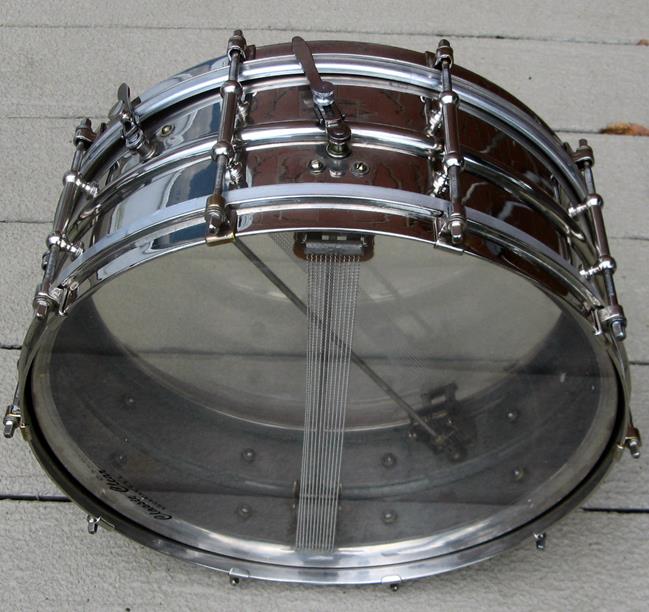

Below
is a Peacock Pearl version of the New Era Sensitive. Special thanks to Australian
drum collector Nick Worsthorne for the great photos of his beautiful snare
drum!


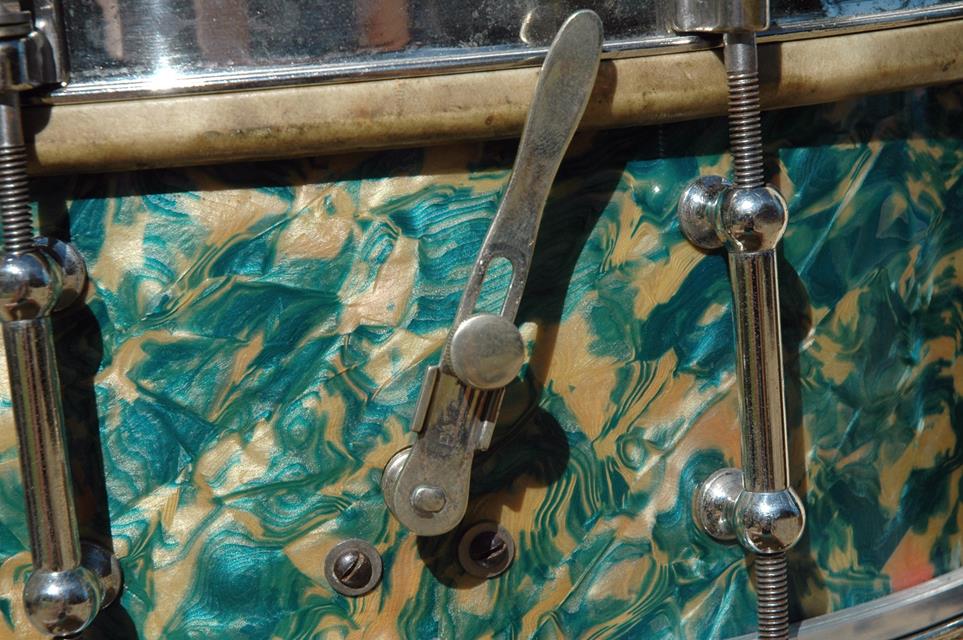


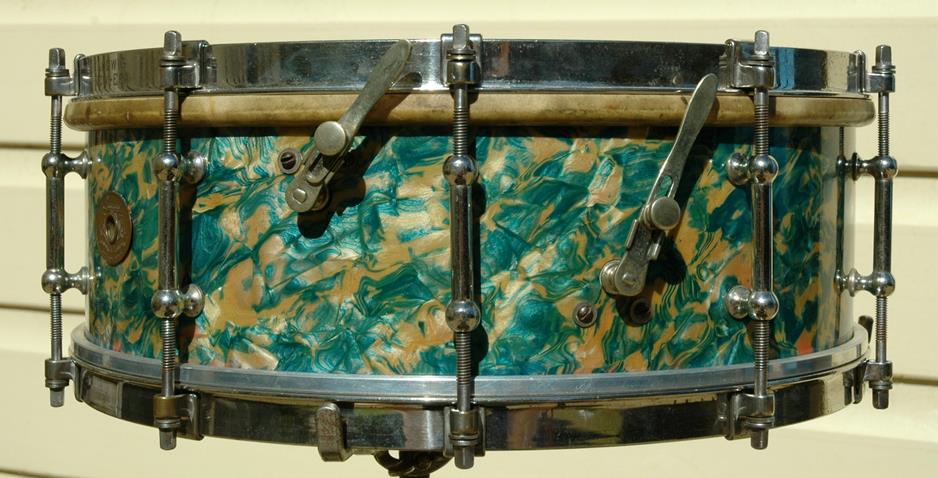

![]()
1935-36 SILVER ANNIVERSARY
Ludwig
& Ludwig strainers were relatively unchanged until around 1936. That year,
the company celebrated its Twenty-Five year anniversary and in honor of this
achievement, they unveiled the Silver Anniversary line of snare drums. The
Super-Ludwig, Super-Sensitive, and Standard models all received a new look. In
addition to newly designed tension cases (lugs) and metal shells, the
Super-Ludwig and Super-Sensitive were given up-dated strainers and snare
guards. The strainer levers were no longer adjustable and were given a unique
hook shaped design. The Standard-Sensitive model with the second set of
internal snares was no longer offered.
NOTE:
While the year 1935 was actually the 25th anniversary of the Ludwig
& Ludwig Drum Company (officially started in the Fall of 1910), the formal
announcement took place in the Spring of 1936 in both the Ludwig Drummer
magazine and the 1936 Ludwig & Ludwig Silver Anniversary Editio n
product catalog. Below is the announcement in the 1936 product catalog. It is
interesting to note that “Founder and President” William F. Ludwig left the
company the following year.
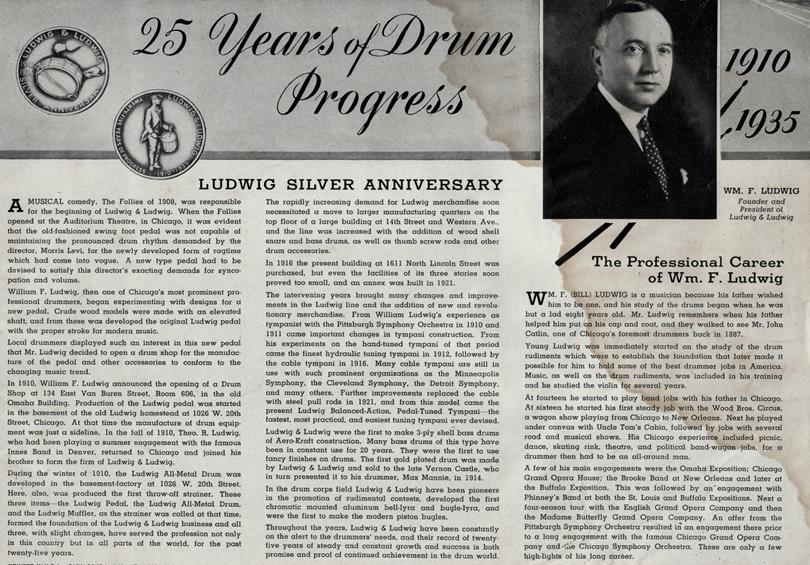
SILVER
ANNIVERSARY SUPER-SENSITIVE MODELS (1935 CATALOG)





1936
SUPER-LUDWIG

1936
STANDARD MODELS

PIONEER
MODEL

UNIVERSAL
MODEL

~1938~
1938
saw yet another change in snare strainer design. The Ludwig & Ludwig
Standard models were fitted with a “New Design Strainer” which is usually
referred to as the Standard three point strainer. These new strainers replaced
the previous Professional strainers which were now being used on the Ludwig
Concert Model 8x15 snare drum. The old reliable Pioneer strainer was still
seeing use on the Pioneer and Universal models.





The Super-Ludwig strainers were unchanged at this point in
time. Below is a photo of a late 1930’s Solid Maple Swing Model.
1937
Super-Swing Model


![]()
~1940~
The
Standard strainer was improved in late 1940 with the addition of an extended
snare capability. New extension brackets were added to both snare and butt
sides of all Standard model snare drums. This allowed the snare strands to
completely cover the entire diameter of the bottom snare head, similar to the
very popular Slingerland Radio King snare drums of the same era.


In
late 1941, a three position strike plate was added behind the strainer lever,
giving the modern Swing drummer the option of tight snares, loose snares or no
snare sound at all. Also that year, a rather novel snare drum called the
Moderne-Bi-Tone snare drum, featuring plastic (Bakelite) lugs was introduced
and the old Pioneer strainer was used on this model. The plastic lug design did
not catch on and it was discontinued after 1941.

![]()
WORLD
WAR TWO 1941-45
In
late 1941, the United States entered World War Two and by 1942, drum production
was severely limited as resources were being redirected to the war effort. Due
to U.S. Government restrictions, very few metal parts were to be used for drum
making. As a result, Ludwig & Ludwig produced a relatively small amount of
Victory model drums. These unique instruments were made using wooden lugs and
hoops. For more information on Ludwig drums and the war, click here: Ludwig
Drums of WWII
The
Victory snare borrowed a very old snare strainer that had been used on the
Tango models of the early 1920’s.
1943
VICTORY DRUM


1943
LUDWIG & LUDWIG VICTORY DRUM STRAINER

![]()
~1948~
World
War Two ended in 1945 but new drum production did not really resume until
1947-48. However, there were really no new products and the old models of 1941
were being offered to the public during the period of 1948-50. The pre-war
white enamel badge was modified slightly in design and for the first time, the
Ludwig & Ludwig badge listed Elkhart, Indiana as its location. This was to
be the end of Ludwig & Ludwig as an independent drum company. Pictured
below is one of the last drums to be made with the Ludwig & Ludwig badge
and is date stamped inside, August 1950 (0850).



LEEDY
& LUDWIG
1951
In
1950, C.G. Conn merged their two drum companies (Ludwig & Ludwig and the
Leedy Manufacturing Company) into one interest and named it Leedy & Ludwig. This new company
would utilize the best features of both and managed to produce some beautiful
and quite unique instruments in its relatively short life. The new drum company
published their exciting new product catalog in 1951. It featured Leedy &
Ludwig’s revolutionary new line of drums called the Knob Tension Drums. These unique drums were tensioned from inside
the drum shells by a series of knobs. When turned like a radio dial, the knobs
caused several levers inside the shell to exert pressure on a metal rims upon
which the heads rested.
1951 KNOB TENSION SNARE
DRUM WITH “FEATHER TOUCH” STRAINER

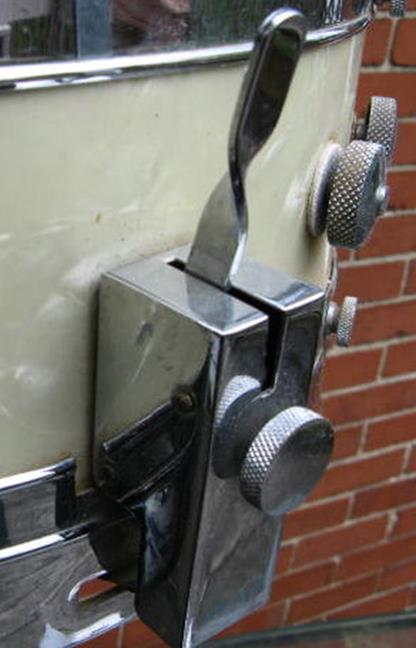

The Leedy & Ludwig company also offered a more standard
line of drums which were basically combinations of pre-war Leedy drums with a
new badge and some Ludwig components. The 1930’s-40’s Ludwig Standard extended
snare strainer was used in combination with the old Leedy butt side
bracket for the Broadway snare drum.
Ludwig & Ludwig’s old reliable Pioneer strainer was used on the New Era
snare drums as well as other lower line drums like the Reliance model. Various
combinations were used during Leedy & Ludwig’s three year existance.


![]()
THE
LUDWIG DRUM COMPANY
1956-65
C.G.
Conn decided to get out of the drum making business entirely and in 1954 they
sold the Leedy name to the Slingerland Drum Company and the Ludwig name to
William F. Ludwig (Ludwig & Ludwig founder and current owner of the W.F.L.
Drum Company). Thus, the Ludwig Drum Company was “born”- again- replacing the
W.F.L. name. Slingerland chose to offer
the Leedy drums as a second and separate line of drums. Around 1955-56, both
companies were in business and published their first catalogs.
The new Ludwig drums were mainly
W.F.L. drums with the name “Ludwig Drum Company” on the old keystone badge.
Between 1956 and 1959, Ludwig offered a few different snare strainers on their
top line drums. The “Classic” strainer was carried over from the W.F.L. period.
Ludwig Super Classic Snare Drum
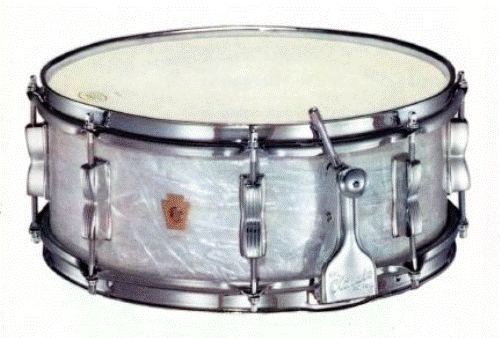
![]()
In 1959, Ludwig introduced a new
snare strainer called the P-83 which was used on their new Supra Phonic 400
metal snare drum, as well as other wood shell drums. It would continue to see
use all through the 1960’s and 1970’s, although the throw-off lever was
slightly modified (note the difference between the strainer in the photo below
and the strainer in the illustrations). A variation of this durable snare
strainer is still in use today!
Ludwig Supra Phonic

P-83 Strainer


Ludwig Jazz Festival Snare Drum

![]()
The
new Ludwig Drum Company offered two Pioneer strainers. The P-85 Large Pioneer
strainer and the P-84 Small Pioneer strainer. Below are catalog illustrations
of the various strainers from the 1959 catalog and the snare drums that used
them.
P-85 Large Pioneer

P-84 Small Pioneer

3x13 Jazz Combo Model

4x13 Las Vegas Model

4x14 Downbeat Model
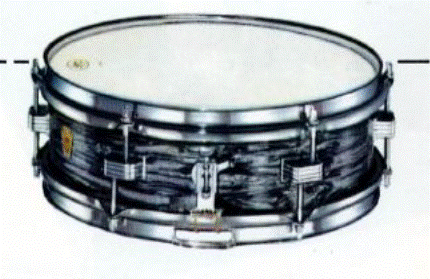
5x14 Pioneer Model

5x13 Super Porto-Pak Model

![]()
~1961-62~
For
some reason, the “Supra Phonic 400” snare drum was changed to the “Super-Ludwig
400” in 1961. Also that year, the Ludwig Super-Sensitive model was again
offered after almost a twenty year absence. While the snare mechanism was very
much as it was in the 1940’s, an updated snare guard was added. Of course, the
Super-Sensitive no longer had a second set of interior snares as in the past
this new version was really a Super-Ludwig. This was somewhat confusing!
Super-Ludwig
400


Super-Sensitive


![]()
~1962-64~
Around
1963, the Super-Sensitive snare strainer received some new plastic components,
making this the first time that a plastic material was utilized in a snare
strainer*. Also, the name “Supra Phonic 400” returned, forever replacing the
name “Super-Ludwig”. This snare drum would become one of the most played and
recorded snare drums of all time and is still available today! A new aluminum
shell snare drum debuted in 1962-63 called the Acrolite. It featured the P-83
strainer. As of 1963, the P-85 Large Pioneer strainer was no longer offered.
*In 1941, Ludwig & Ludwig
offered plastic lugs on their Moderne Bi-Tone snare drum (see “Ludwig Lugs” in
this article).
SUPER-SENSITIVE
STRAINER

ACROLITE MODEL

TO CONTINUE OR RETURN
TO ANY OTHER SECTION IN THIS GUIDE OR TO RETURN “HOME”, CLICK ON A LINK BELOW…